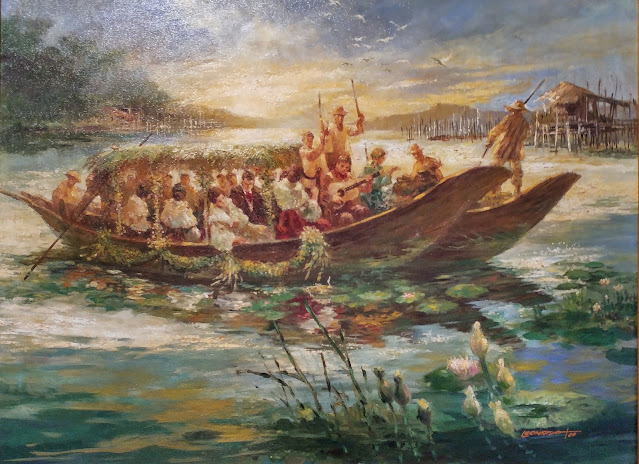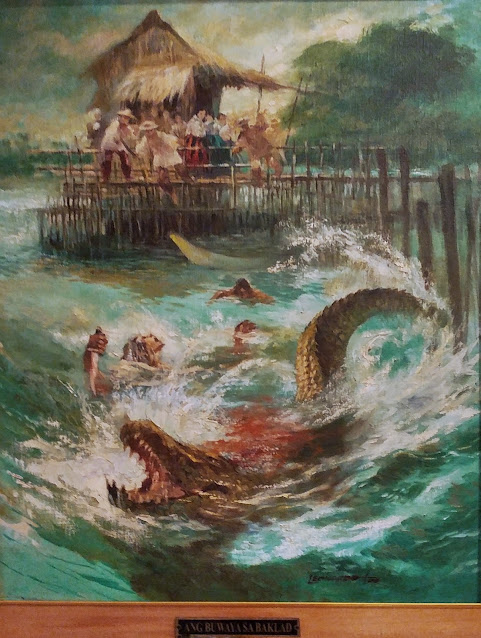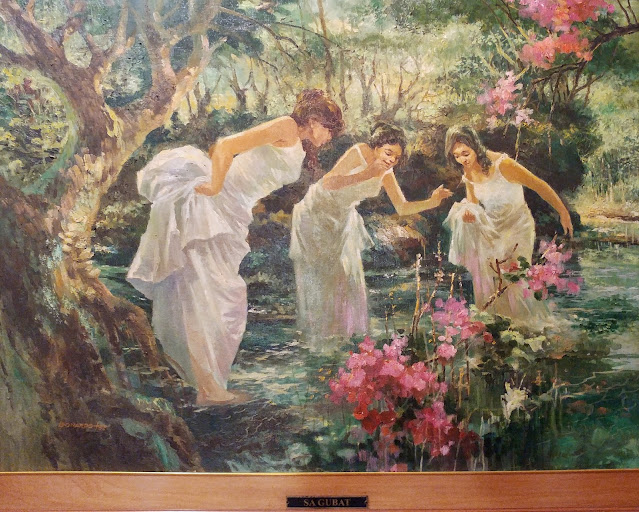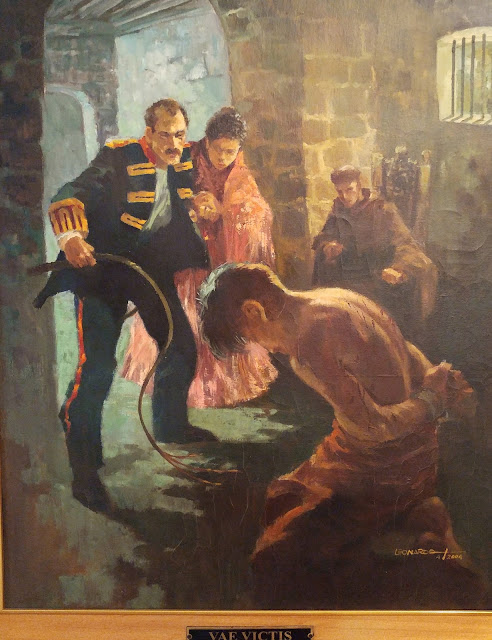It was a Saturday morning when I went to the National Museum of Fine Arts. And if it weren't for a group of young people who were taking a selfie, I wouldn't have known that there is a special exhibit of twenty-eight Noli Me Tangere Paintings by Leonardo Tayao Cruz.
This is the largest collection of paintings inspired by Jose Rizal's novel.
When one of the security guards approached the group to ask them to refrain from making a lot of noise, I got to talk to her afterward about the Museum. She advised me of the Noli Me Tangere exhibit which is located on the Judiciary Floor (Sandiganbayan Reception Hall and Gallery). Right after my conversation with the guard, I went directly to the ground floor to see the paintings.
The oil paintings were completed between 2002 and 2006. They were previously displayed at the Rizal Shrine in Fort Santiago in 2008. The paintings were done in the classical-impressionist style which the artist is known for.
It would be great if the National Museum could come up with a more visible way of showing what types of exhibits are available. If it weren't for that rambunctious group, I wouldn't have known about the paintings.
When I stepped off the elevator, I felt like Harry Potter on his way to the Room of Mysteries. The hallway leading to the gallery was a little dark and creepy. It was fortunate that I immediately saw a security guard; if not I don't think I would have proceeded.
To relate the Art to the book, I've included excerpts to describe each painting. I'm using the Leon M. Guerrero English translation which I also referred to in my earlier post about Noli Me Tangere: The Secrets of Jose Rizal's Noli Me Tangere.
A Party (Ang Pagtitipon)
Don Santiago de los Santos was giving a dinner party one evening towards the end of October in the 1880's. Although, contrary to his usual practice, he had let it be known only on the afternoon of the same day, it was soon, the topic of conversation in Binondo, where he lived, in other districts of Manila, and even in the Spanish walled city of Intramuros.
 |
| Ang Pagtitipon |
The dinner guests were gathered in the main reception room which had great mirrors and sparkling chandeliers. On a pinewood platform stood enthroned a magnificent grand piano, for which an exorbitant price had been paid, and which this night seemed more precious still because nobody was presumptuous enough to play on it. There was also a large portrait in oils of a good-looking man in a frock coat, stiff and straight, as well-balanced as the tasseled cane of office between his rigid ring-covered fingers, who seemed to be saying: 'See what a lot of clothes I have on, and how dignified I look.'
Crisostomo Ibarra
If all eyes, even Father Sibyla's, were turned on the new arrivals, it was not because they were a pair of "elegant beauties", and if the lieutenant was so shaken out of his reflections that he involuntarily took a step forward, while, Father Damaso sat frozen in his armchair, it was not because the Governor General himself had entered with his aides. In fact it was only the original of the portrait on the wall, leading by the arm a young arm in deep mourning.
 |
| Crisostomo Ibarra |
Capitan Tiago first greeted his guests, kissing the hands of the priests, who were still so taken aback that they forgot to reciprocate with the customary blessing. Then he introduced his companion as Don Crisostomo Ibarra, the son of a lately deceased friend, whom he had gone to meet upon his return from Europe.
Capitan Tiago
Capitan Tiago looked younger than he really was; he would have been taken for thirty or thirty-five years old. He was short and rotund, thanks to an abundance of fat that, according to his friends, was a sign of heavenly favor, and, to his enemies, came from battening on the poor. Light-brown in complexion, his face wore at the time of his story a habitually amiable expression.
 |
| Kapitan Tiyago |
He soon married a good-looking girl from the district of Santa Cruz, who only gave him social position, but also helped him make his fortune. Dona Pia Alba, for that was the name of his wife, was not satisfied doing business in sugar, coffee, and indigo. She also wanted to manage a farm, and the couple bought lands in San Diego, at which time they had made friends with Father Damaso and Don Rafael Ibarra, the wealthiest landowner of the town.
Love on A Balcony (Sa Asotea)
At first they only exchanged pleasantries. But women are sisters of Cain and she was jealous.
'Did you think of me?' she asked. 'Always? Didn't you ever forget me? You've travelled so much; you've seen so many cities, with so many beautiful women!'
'How could I forget you?' Men are, for that matter, also brothers of Cain, and know how to lie and evade. 'How could I,' he asked, looking into her dark eyes, 'forget an oath, a sacred oath?'
She began to tease him about their childhood games and quarrels. He had been such a cheat, and such a bad loser, and he had always wanted the best of everything. Once they had gone bathing in a river with his mother. He had already started school with the Jesuits in Manila, and had told her the Latin and Spanish names of the familiar plants and flowers on their way, but she had gone off chasing butterflies. Then he had made for her a wreath of orange leaves and flowers, but his mother had taken it and crushed the flowers into their native hair shampoo.
Tasio
Well-bred people called him by his real name, which was Don Anastasio, or Tasio the scholar; the ill-bred, who were in the majority, called him Tasio the fool for his unorthodox ideas and odd behaviour.
Then, seeing two boys about ten and seven years old, he went towards them without pausing for a reply.
'Coming with me, boys?' he asked them. 'Your mother has cooked you a dinner fit for friars.'
'The head sacristan won't let us go until eight, sir,' the older boy answered. 'I hope I can get my pay tonight for mother.'
A Fishing Expedition
 |
| Tasio |
Well-bred people called him by his real name, which was Don Anastasio, or Tasio the scholar; the ill-bred, who were in the majority, called him Tasio the fool for his unorthodox ideas and odd behaviour.
Then, seeing two boys about ten and seven years old, he went towards them without pausing for a reply.
'Coming with me, boys?' he asked them. 'Your mother has cooked you a dinner fit for friars.'
'The head sacristan won't let us go until eight, sir,' the older boy answered. 'I hope I can get my pay tonight for mother.'
A Fishing Expedition
 |
When they reached the shore the women cried out a happy surprise. They saw two large boats joined together and picturesquely decorated with garlands of flowers and varicoloured embossed cloths. From the makeshift awnings hung tiny paper lanterns among roses and carnations, and pineapples, kasuy, bananas, guavas, lanzones, and other fruits. Ibarra had brought carpets, rugs, and cushions, and fashioned them into comfortable seats for the women. Even the paddles and the punting poles were decorated. In the more lavishly accoutred boat were a harp, guitars, accordions, and a carabao horn trumpet; the other had native earthen stoves in full blast, brewing tea, coffee, and ginger tea for breakfast.
A Crocodile in the Fishtrap
In the Wood
From his hiding place Father Salvi could now see Maria Clara, Victoria, and Sinang wading in the brook. The three moved with their eyes fixed on the mirror of the waters, searching for the mysterious heron's nest. They were wet up to the knees and the billowing folds of their bathing skirts outlined the graceful curves of their legs. Their hair was undone and their arms bare. They wore striped blouses of bright colours. They were picking the flowers and wild roots that grew on the river bank as they went on their quest of the impossible.
Elias and Salome
'Then at least,' Salome told him lovingly, 'stay here when I have gone, live in this cottage. It will make you remember me, and from far away I shall not fear that my house has gone with the wind of the waves. And when I think of this place, the memory of you and the memory of my home will be one. Sleep here, where I have slept and dreamt. It will be as if I myself were living here with you, as if I were at your side...'
In the Scholar's House
The first thing he saw was the old man, bent over a book in which he seemed to be writing. Collections of insects and leaves were hung on the walls among maps and old bookcases crammed with printed volumes and manuscripts.
A Crocodile in the Fishtrap
 |
| Ang Buwaya sa Baklad |
'I say there's a crocodile caught in the trap,' said Leon and, plunging the pole into the water up to the handle, he continued: 'Hear that?' That's not sand; that's tough hide, the crocodile's back. Do you see those stakes shaking? It's struggling but it's all coiled up. Wait...it's a big one. Must be a yard thick all round.'
In the Wood
 |
| Sa Gubat |
From his hiding place Father Salvi could now see Maria Clara, Victoria, and Sinang wading in the brook. The three moved with their eyes fixed on the mirror of the waters, searching for the mysterious heron's nest. They were wet up to the knees and the billowing folds of their bathing skirts outlined the graceful curves of their legs. Their hair was undone and their arms bare. They wore striped blouses of bright colours. They were picking the flowers and wild roots that grew on the river bank as they went on their quest of the impossible.
Elias and Salome
 |
| Elias at Salome |
'Then at least,' Salome told him lovingly, 'stay here when I have gone, live in this cottage. It will make you remember me, and from far away I shall not fear that my house has gone with the wind of the waves. And when I think of this place, the memory of you and the memory of my home will be one. Sleep here, where I have slept and dreamt. It will be as if I myself were living here with you, as if I were at your side...'
In the Scholar's House
The first thing he saw was the old man, bent over a book in which he seemed to be writing. Collections of insects and leaves were hung on the walls among maps and old bookcases crammed with printed volumes and manuscripts.
The scholar was so absorbed in his task that he noticed the young man's arrival only when the latter, not wishing to disturb him, was on the point of withdrawing.
At Nightfall
Scarcely knowing what she was doing, she went up quickly to the wretch's basket and dropped in the reliquary which her father had just given her.
'What have you done?' her friends cried out.
'I had nothing else to give,' she answered, disguising with a smile the tears in her eyes.
The Banquet
He raised his arm, but a girl, swift as light, flew between them and with her soft hands stopped the avenging arm. It was Maria Clara. Ibarra stared at her with the eyes of a madman. Slowly the clenched fingers of his hands loosened, dropping the knife and releasing the Franciscan. Then, covering his face, he fled through the crowd.
His Excellency
 |
| Sa Bahay ng Pilosopo |
At Nightfall
 |
| Takipsilim |
Scarcely knowing what she was doing, she went up quickly to the wretch's basket and dropped in the reliquary which her father had just given her.
'What have you done?' her friends cried out.
'I had nothing else to give,' she answered, disguising with a smile the tears in her eyes.
The Banquet
He raised his arm, but a girl, swift as light, flew between them and with her soft hands stopped the avenging arm. It was Maria Clara. Ibarra stared at her with the eyes of a madman. Slowly the clenched fingers of his hands loosened, dropping the knife and releasing the Franciscan. Then, covering his face, he fled through the crowd.
 |
| Pananghalian |
His Excellency
 |
| Kapitan Heneral |
Ibarra was dressed in strict mourning. Although the visit of the friars did not seem a good omen for him, he presented himself serenely and gave a deep bow.
The Governor General took several steps toward him.
'I take the greatest pleasure in shaking your hand, Mr. Ibarra. Allow me to receive you in this intimate fashion.'
The Procession
 |
| Ang Prusisyon |
The Governor-General, who had been inspecting the town on foot, accompanied by his two aides, Capitan Tiago, the Provincial Governor, the commanding office, and Ibarra, preceded by Constabulary soldiers and municipal policemen who opened and cleared a way for them, was invited to watch the procession from the house of the Mayor, who had put up a small stage in front of it from which an ode would be recited in praise of the patron saint.
Doña Consolacion
 |
| Dona Consolacion |
Doña Consolacion realized she had betrayed herself. She was overcome with shame, and, being far from feminine, shame took the form of rage and hatred. She showed the imprudent soldier the door and closed it after him with a kick. She took a few turns about the room, twisting the whip in her nervous hands, and then, stopping suddenly before the madwoman, commanded her in Spanish: 'Dance!'
The Espadañas
Capitan Tiago, followed by Aunt Isabel, went running downstairs to receive the new arrivals. They were Doctor Don Tiburcio de Espadaña, his wife the Madam Doctor Dona Victorina de los Reyes de de Espadaña, and a young Spaniard with an attractive face and an engaging presence.
 |
| Mag-asawang Espadana |
The Oppressed
They entered a cave which sank down into the depths of earth. The guide, who knew the way, warned Elias when they were on an incline, or when he was to stoop or crawl on his belly. For all that they did not take long to reach a kind of hall, lighted meanly by pitch torches, and occupied by twleve or fifteen armed men with unwashed faces and wretched clothes, some seated, others, on their backs, scarcely speaking to one another.
 |
| Mga Inu-usig |
The Cockpit
The Sabbath day is generally kept holy in the Philippines by going to the cockpit in the afternoon. Just as in Spain it is kept by going to the bullring. Introduced and exploited for a century, cockfighting was at the time one of the vices of the people, even more widespread than opium-smoking among the Chinese.
 |
| Ang Sabungan |
Spokesman of the Oppressed
Elias was speaking with passion and enthusiasm; his eyes were flashing and his voice vibrant. An impressive pause followed. The boat, unidsturbed by the paddle, seemed to float motionless on the water; the moon, shone splendidly in the dark blue sky; on the distant shore a few lights gleaned.
Quid Quid Latet (The Conspiracy)
Crisostomo looked at him terrified, but Elias shook him by the arm and said in a bitter voice burning with hatred: 'Look at me well; judge whether I have suffered; and you are alive, you love, you have wealth, a home, honours---you live, you live!'
Beside himself, he ran to a small collection of arms, but he had scarcely seized two daggers when he dropped them and stared like a madman at Ibarra, who remained motionless.
'What was I going to do?' he muttered and fled from the house.
Vae Victis (Woe to the Vanquished)
At a sign from the lieutenant, a soldier, armed with the whip, began his grisly task. Tarsilo's whole body shook; a long muffled roar was heard through the gag that covered his mouth; he lowered his head; the bloodstains spreading through his clothes.
The One to Blame
Ibarra saw the smoking ruins of his house, his ancestral home, where he had been born and which had kept alive for him the sweetest memories of his childhood and adolescence. The tears which he had so long kept back now poured forth; he bent his head and, his arms tied, wept without the measure of relief which he might have had if he had been able to conceal his tears, or if his sorrow had moved anyone to pity. Now he had neither country nor home, neither loves nor friends nor a future.
A Wedding for Maria Clara
'I am only a man on the run. Soon they will discover my escape.'
Maria Clara held the young man's head in her hands, kissed his lips again and again, embraced him, and then pushed him away.
'Go! Go quickly! Goodbye!'
Father Damaso explains himself
'My God, my God,' cried the priest, covering his face with his hands, 'You punish me, and I accept it. But watch over my daughter!' Then, turning to the girl, 'Do you want to be a nun? So you shall be. I will not have you die.' Maria Clara fell to her knees, seized his hands, and pressed and kissed them.
Noche Buena (Christmas Eve)
'Listen,' he continued in a weakening voice, 'I shall be dead too before daybreak. Twenty paces from here, make a pyre, put out bodies on it, cover us, and set the wood on fire, a great fire, until we are turned to ashes.'
Basilio listened.
'Then, if nobody else comes; dig here. You will find much gold. It will all be yours. Study!'
The voice of the unknown was growing ever more unintelligible.
'Go and look for the firewood. I want to help you.'
Basilio went away. The unknown turned his face to the East and whispered as if in prayer: 'Nothing will remain of me...I die without seeing the sun rise on my country. You who are to see the dawn, welcome it, and do not forget those who fell during the night.'
He raised his eyes to the sky, his lips moved as if to say a prayer, then he lowered his head and fell slowly to the ground...
Epilogue
The casual passerby along the first street in Chinatown of an evening was likely to see, seated in a Chinese store, a small jaundiced man, thin, bent, with sunken dreamy eyes and muddy lips and nails, staring out at the people without seeing them. At nightfall he would struggle to his feet and, leaning on a cane, head for a narrow alley and enter a disreputable hut over whose door a sign in large red letters said: Opium Smoking. Open to the Public.
This was what was left of the famous Capitan Tiago, now utterly forgotten even by the head sacristan.
The National Museum of Fine Arts is located on Padre Burgos Avenue, Ermita, Manila. They are open from 10AM to 5PM, Tuesdays to Sundays.
More Readings About Noli Me Tangere:












Comments
I also ask permission to use Pilosopo Tasyo with Basilio & Crispin for my daughter's school report.
Lyn M. Barba
May I also ask permission to use the photo depicting Pilosopo Tasyo talking to the ill-fated brothers Basilio & Crispin for my daughter's school report? Thanks in advance!
Homeschooling mom